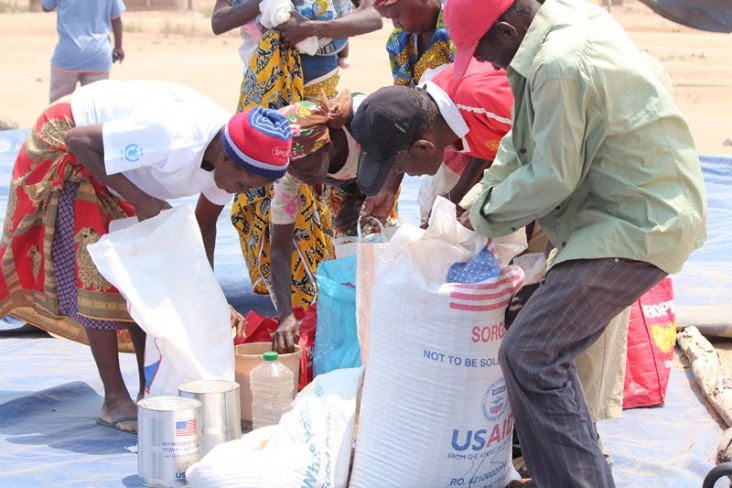
The country’s food security situation is fragile. Zimbabwe is in the midst of a severe drought that has caused large-scale crop failure throughout the country, which makes it difficult for farmers to maintain healthy livestock and grow crops. The Zimbabwe Vulnerability Assessment Committee estimates that 4.1 million (42 percent of the rural population) will be food insecure during the period from January to March 2017.
USAID’s food security activities are designed to transition assistance from short-term food aid to longer-term developmental food security and increased incomes. Activities focus on improving the enabling environment for food security, increasing the productivity of households and micro, small and medium sized enterprises, and increasing the resilience of vulnerable communities.
USAID Response to the El Niño induced Drought
Since June 2015, we have contributed $127 million in emergency food assistance to respond to the drought in Zimbabwe. With this Food for Peace funding, USAID is providing critical food and nutrition assistance while helping mitigate the negative effects of the drought on vulnerable households and ensuring that they can recover quickly and be resilient in the face of future crises.
Over 1.6 million Zimbabweans are receiving some form of drought relief from USAID. That is in addition to over half a million Zimbabweans who receive ongoing assistance from us through our long-term food security activities. Our suppport helps meet growing needs by expanding food assistance now and during the upcoming lean season, and by providing nutrition and health support, access to safe drinking water, and seeds and livestock support to promote agricultural recovery.
We are channeling all food aid through partner organizations and are rigorously monitoring the process during targeting, distribution, and post-distribution to ensure it reaches and benefits only the most vulnerable.
USAID Support for Recovery during the drought
USAID’s Office of Foreign Disaster Assistance is funding activities to meet additional needs of drought-affected communities and help facilitate a quick recovery. This includes activities that aim to improve access to health and nutrition services, increase access to safe drinking water, promote sanitation and hygiene, protect livestock-based livelihoods, and restore agricultural productivity.
USAID Development Food Assistance Programs
In addition to providing humanitarian assistance, USAID through the U.S. Government’s Food for Peace program is continuing to adapt significant and ongoing development investments to mitigate impacts of El Niño. These include support to activities that increase household incomes, facilitating linkages between subsistence farmers and markets, and building resilience to climatic shocks and stresses.
In 2013, we launched two, five-year activities to help address the underlying causes of chronic food insecurity and malnutrition in rural areas. The activities improve resilience and will help reduce future humanitarian food needs. As one component, we provide supplementary food assistance for over 100,000 pregnant and lactating women and children under the age of two to improve child health and nutrition. The entire community also benefits from health and nutrition training; improved water and sanitation systems; and training to promote greater agricultural productivity and incomes.
In addition, USAID and its partners help communities to identify and create community productive assets to promote livelihoods and better withstand shocks, including recurrent drought. Vulnerable households also receive cash or food in exchange for labor to the produce shared assets. Over the past three years, with our support, communities have constructed or rehabilitated more than 30 assets, including dip tanks, irrigation schemes, dams, and community gardens helping build their resilience. A dam for example, benefits the current and future generations in hard to reach communities, as it will provide water for their community garden to help them improve food security, incomes, and nutrition. The productive assets are benefiting more than 25,000 rural families.
Feed the Future Activities
To help Zimbabweans transition from emergency humanitarian aid towards long-term economic stability, our interventions promote agricultural recovery and livelihood development. The Feed the Future initiative, which aims to reduce poverty and malnutrition, increase food security, and enhance economic recovery, guides our food security interventions. We work with both the private sector and civil society to rebuild deteriorated market linkages and provide training and support for small-scale farmers, particularly in drought prone areas. Since 2010, we have assisted over 140,000 smallholder farmers and linked about 30,900 farmers to markets over a five-year period. As a result, some farmers who made $200 a year are now making $10,000 a year.
In 2015, USAID launched three new, five-year activities with a combined value of $21.5 million focused on crops, livestock, natural resource management, and water, sanitation, and hygiene. These activities benefit more than 350,000 people through training and technical assistance in good agricultural practices, business skills and natural resource management. The activities also help smallholder farmers access to markets and credit; increase their income, and increase their access to clean water and sanitation.








Comment
Make a general inquiry or suggest an improvement.